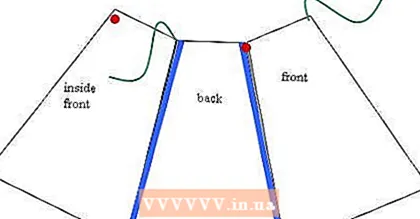Author:
Ellen Moore
Date Of Creation:
17 January 2021
Update Date:
2 July 2024

Content
- Steps
- Method 1 of 3: Using baking soda
- Method 2 of 3: Remove the seeds and shorten the cooking time
- Method 3 of 3: How to choose tomatoes
Tomatoes not only add nutritional value to your favorite dishes, but also make them taste good. Because tomatoes are very acidic, they can cause serious problems for people with ulcers or other acid-related diseases of the digestive system. To reduce the acidity of cooked tomatoes, add some baking soda to them. You can also remove the seeds, shorten the cooking time, and use them raw.
Steps
Method 1 of 3: Using baking soda
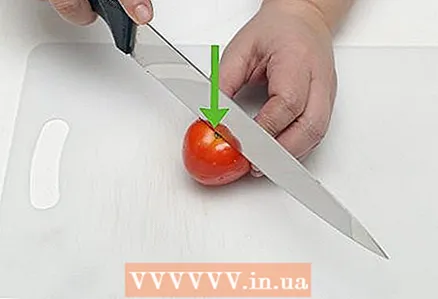 1 Cut the tomatoes into pieces. Chopped tomatoes are used in many dishes. The size of the pieces will depend on the food you are preparing.
1 Cut the tomatoes into pieces. Chopped tomatoes are used in many dishes. The size of the pieces will depend on the food you are preparing. - Note that the smaller the pieces, the faster they will warm up.
 2 Simmer the tomato slices over medium heat for 10 minutes. If you are going to add tomatoes to another hot dish, then you may not have to cook them that long. If you cut the tomatoes into large chunks, cook them a little longer.
2 Simmer the tomato slices over medium heat for 10 minutes. If you are going to add tomatoes to another hot dish, then you may not have to cook them that long. If you cut the tomatoes into large chunks, cook them a little longer. - Watch the tomatoes very closely and immediately remove them from the heat if they start to burn or dry out too much.
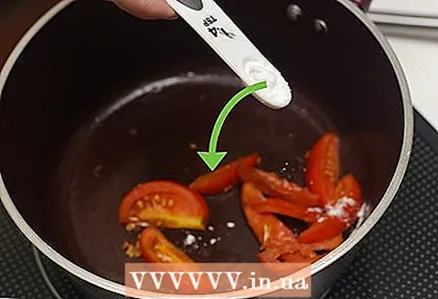 3 Remove the pan from the stove and add 1/4 teaspoon of baking soda for six medium tomatoes. If you need to cook more or less tomatoes, adjust the amount of baking soda accordingly. Stir the contents of the skillet to get the baking soda on all the tomato slices.
3 Remove the pan from the stove and add 1/4 teaspoon of baking soda for six medium tomatoes. If you need to cook more or less tomatoes, adjust the amount of baking soda accordingly. Stir the contents of the skillet to get the baking soda on all the tomato slices. - On contact with the acid in the tomatoes, the soda will sizzle.
 4 Add the rest of the ingredients and cook until tender. When the hissing stops (which may take about a minute), finish cooking. The baking soda will reduce the overall acid content of the dish without altering its flavor.
4 Add the rest of the ingredients and cook until tender. When the hissing stops (which may take about a minute), finish cooking. The baking soda will reduce the overall acid content of the dish without altering its flavor.
Method 2 of 3: Remove the seeds and shorten the cooking time
 1 Remove tomato seeds. Carefully cut the tomato in half exactly in the middle so that the stem remains on one side and the bottom on the other. Then take out the tomato seeds with a teaspoon and discard them. Be careful not to get too deep into the tomato pulp.
1 Remove tomato seeds. Carefully cut the tomato in half exactly in the middle so that the stem remains on one side and the bottom on the other. Then take out the tomato seeds with a teaspoon and discard them. Be careful not to get too deep into the tomato pulp. - The seeds contain bOMost of the acidity in tomatoes is why removing them is a great way to reduce acidity.
- Some dishes are made better by cooking the seeds along with the tomato pulp, so consider this before removing the seeds.
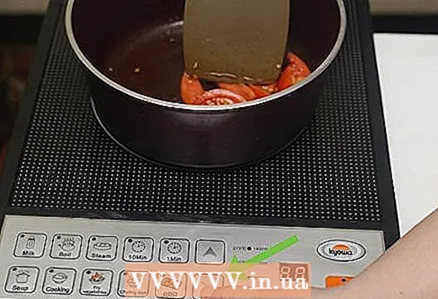 2 Reduce your tomato cooking time. Tomatoes become more acidic the longer they cook - keep cooking times as low as possible to reduce acid levels. Sauces and other dishes that need to boil for a long time can make it difficult for you, but in general, tomatoes are not recommended to cook for more than an hour and a half.
2 Reduce your tomato cooking time. Tomatoes become more acidic the longer they cook - keep cooking times as low as possible to reduce acid levels. Sauces and other dishes that need to boil for a long time can make it difficult for you, but in general, tomatoes are not recommended to cook for more than an hour and a half. - You may have to get used to undercooked tomatoes, but if you're having problems with acidic foods, it's worth it.
 3 Add the tomatoes last. If the dish includes tomatoes, but they are not the main ingredient, add them when all the other ingredients are almost ready. This will shorten the cooking time without giving up on it altogether.
3 Add the tomatoes last. If the dish includes tomatoes, but they are not the main ingredient, add them when all the other ingredients are almost ready. This will shorten the cooking time without giving up on it altogether. - If the ingredients need to be stewed within an hour, add the tomatoes in the last 10 minutes. So they will have time to warm up a little and soak into the dish, but they will not become too sour.
 4 Add raw tomatoes to the dish. You can reduce the acidity of tomatoes by not only shortening their cooking time, but also using raw tomatoes. Raw tomatoes are significantly less acidic than cooked ones. If tomatoes can be added to a dish raw without significantly affecting the dish, it will make the dish less sour.
4 Add raw tomatoes to the dish. You can reduce the acidity of tomatoes by not only shortening their cooking time, but also using raw tomatoes. Raw tomatoes are significantly less acidic than cooked ones. If tomatoes can be added to a dish raw without significantly affecting the dish, it will make the dish less sour. - If you add tomatoes to a hot dish, the other ingredients are likely to heat the tomatoes enough and even out the temperature in the dish.
Method 3 of 3: How to choose tomatoes
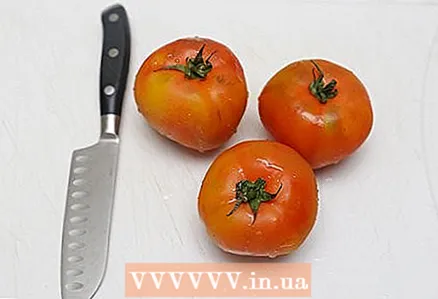 1 Take the juiciest tomatoes. Tomatoes lose acidity as they ripen, so don't buy tomatoes that are not yet fully ripe. To check the maturity of a tomato, estimate its weight and squeeze gently. Choose heavier and softer tomatoes.
1 Take the juiciest tomatoes. Tomatoes lose acidity as they ripen, so don't buy tomatoes that are not yet fully ripe. To check the maturity of a tomato, estimate its weight and squeeze gently. Choose heavier and softer tomatoes. - Heavy tomatoes contain more juice, which means they are more ripe. Soft (but not overly) tomatoes are more ripe than hard ones.
- In addition, a ripe tomato can be distinguished from an unripe tomato by its smell.
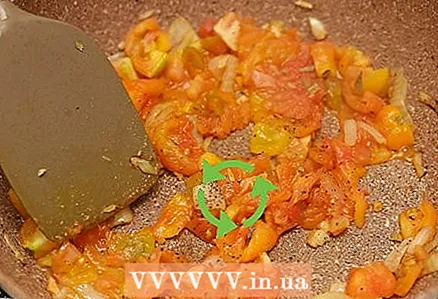 2 Use fresh tomatoes in your cooking. Tomatoes become more acidic during canning, so cook only fresh tomatoes to reduce the acidity of your dishes. The disadvantage of this method is that you will have to buy fresh tomatoes much more often than canned ones, as they quickly disappear.
2 Use fresh tomatoes in your cooking. Tomatoes become more acidic during canning, so cook only fresh tomatoes to reduce the acidity of your dishes. The disadvantage of this method is that you will have to buy fresh tomatoes much more often than canned ones, as they quickly disappear. 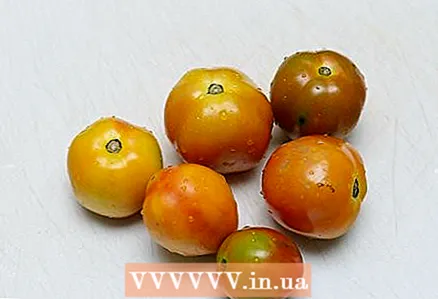 3 Don't use red tomatoes. Tomatoes come in different colors - red, green, yellow, orange and their shades. Rumor has it that red tomatoes have significantly more acidity than others. Next time you cook your favorite tomato dish, try adding a different variety of tomatoes and see if you notice a difference.
3 Don't use red tomatoes. Tomatoes come in different colors - red, green, yellow, orange and their shades. Rumor has it that red tomatoes have significantly more acidity than others. Next time you cook your favorite tomato dish, try adding a different variety of tomatoes and see if you notice a difference. - And although this statement seems to be true, it is not an axiom, as there are red varieties with low acidity and not red varieties with high acidity.
- Here are a few varieties to look out for: yellow pear (similar to cherry tomatoes), georgia striped (yellow variety), and large rainbow (golden red tomato).
